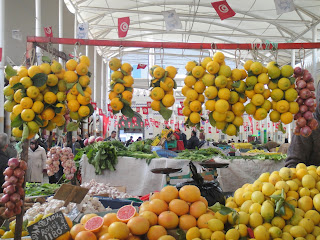Karen’s home is the middle unit in a three-unit row-house. The walls inside and out are covered in an extraordinarily hard plaster, and the floors are marble, keeping the interior cool (and echo-y).
Christmas eve, Paige hosted a visit by Papito and Ashmaya, the delightful children of Karen’s across-the-street neighbours Reem and Nejmadin. Paige helped the two kids hand-paint ornaments and decorate the tree (which Moira had painstakingly assembled). This was Papito’s and Ashmaya’s first-ever Christmas-tree-decorating experience.
Christmas day we hosted a traditional turkey dinner for the above-named neighbours and for Karen’s colleague Pauline and Pauline’s husband Tony (Kiwis who have been in Tunis for 17 years). The Tunisians tucked into the turkey, potato casserole, squash, stuffing, and gravy with gusto, and later said that the evening was a memorable “first” for them.






















































